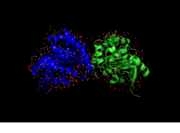User:SarahZimmerman/Sandbox 1
From Proteopedia
|
Contents |
ag85C of Mycobacterium tuberculosis
SarahZimmerman/Sandbox 1. Click above on edit this page to modify. Be careful with the < and > signs. You may include any references to papers as in: the use of JSmol in Proteopedia [1] or to the article describing Jmol [2] to the rescue.
Introduction
Mycobacterium tuberculosis is the bacteria that causes the tuberculosis (TB) disease itself, a leading infectious cause of death world-wide. Thus, it is necessary to develop antimycobacterial drugs. However, this has proven to be difficult as the bacteria can become resistant as a result of misuse of drugs. This gives the bacteria time to mutate which ultimately leads to the drug resistance. To combat this, scientists and researchers have taken on many studies and clinical trials to locate specific drug targets. Obstacles for controlling TB infection include lengthy treatment regimens, drug resistance, lack of a highly efficacious vaccine, and incomplete understanding of the factors that control virulence and disease progression. Of these projects, some deal specifically with the M. tuberculosis Antigen 85 (Ag85) complex. Ag85 complex consists of 3 secreted enzymes (A, B, and C) and plays a key role in pathogenesis and cell wall synthesis of M. tuberculosis. (3) The cell wall of mycobacterium tuberculosis consists of covalently linked molecules, one of which is mycolic acid, a fatty acid which exists in the membrane as the free glycolipids trehalose monomycolate (TMM) and trehalose dimycolate (TDM). Studies suggest that these three components are necessary to maintain the integrity of the cell wall. (Gobec) The entire Ag85 complex has been shown to display mycolyltransferase activity. More specifically, Ag85C is important in the generation of the bacterial cell wall in that it transfers the mycolic acid to the rest of the Ag85 complex, and thus it is suggested that the enzyme displays mycolyltransferace activity. (4) Specifically, the Ag85 enzymes catalyze the transfer of a mycolyl residue from one molecule of alpha, alpha-trehalose monomycolate (TMM) to another TMM, leading to the formation of TDM (catalyze the transfer of a mycoloyl residue from one molecule of alpha,alpha-trehalose monomycolate (TMM) to another TMM, leading to the formation of TDM). Trehalose is necessary for proper growth of the bacterial cells. Thus, there is potential to target these enzymes with specific drugs to prevent the spread of the disease (Favrot).
Structure
Ag85 C is a dimer of identical subunits, and quite a bit about the amino acid sequence and overall structure of Ag85C is known. The enzyme contains a catalytic triad comprised of serine glutamate and histidine. This would lead us to think that we could shut down the enzyme by directly inhibiting the serine residue of the catalytic triad, but we can instead modify a near by cysteine residue and have the same effect. This was determined by a series of experiments in which scientists generated various mutants and modifications of the Ag85C enzyme. (5)
Catalytic Triad
Active Site
Cysteine 209
Clinical Relevance
Because the cell wall envelope of M. tuberculosis is essential for the bacteria’s viability and virulence, it is the primary target for antimycobacterial drugs. Comprised within the cell wall is mycolic acid, a fatty acid which exists as the free glycolipids trehalose monomycolate (TMM) and trehalose dimycolate (TDM) (Gobec, 2004). It is known that the ag85 complex with its three protein components (A, B, and C) plays a key role in cell wall biosynthesis and the transfer of mycolic acid from one molecule of TMM to another. The resultant molecule, TDM, has been suggested to be important in maintaining M. tuberculosis cell wall integrity. Studies have also suggested that removal of ag85C from a strain of M. tuberculosis results in a significant decrease in the presence of cell-wall linked mycolic acids. Thus, scientists hypothesize that inhibition of ag85C and its mycolyltransferase activity will disrupt TDM and its ability to maintain cell wall integrity (Gobec et al, 2004). Knowing this, researchers have suggested that inhibition of mycolic acid transfer and, ultimately, ag85C, must be involved in the continuously-developing class of antimycobacterial drugs aimed at combatting M. tuberculosis (Belisle et al, 1997).
References
- ↑ Hanson, R. M., Prilusky, J., Renjian, Z., Nakane, T. and Sussman, J. L. (2013), JSmol and the Next-Generation Web-Based Representation of 3D Molecular Structure as Applied to Proteopedia. Isr. J. Chem., 53:207-216. doi:http://dx.doi.org/10.1002/ijch.201300024
- ↑ Herraez A. Biomolecules in the computer: Jmol to the rescue. Biochem Mol Biol Educ. 2006 Jul;34(4):255-61. doi: 10.1002/bmb.2006.494034042644. PMID:21638687 doi:10.1002/bmb.2006.494034042644
1. Belisle JT, Varalakshmi DV, Sievert T, Takayama K, Brennan PJ, Besra GS. 1997. Role of the Major Antigen of Mycobacterium tuberculosis in Cell Wall Biogenesis. Science 276: 1420-1422.

